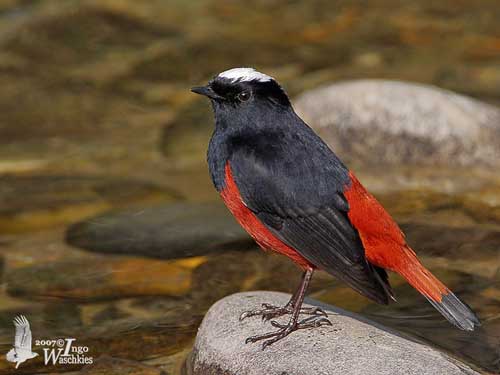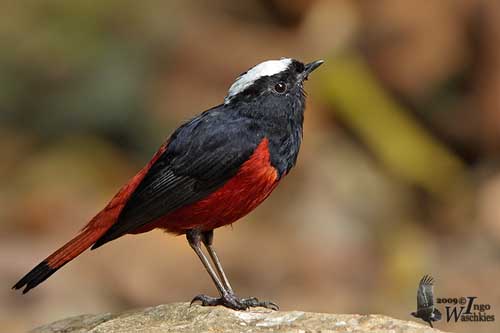
Fr: Torrentaire à calotte blanche
All : Weißkopfschmätzer
Esp: Colirrojo de Capa Blanca
Ital : Codirosso corona bianca
Nd : Rivier-roodstaart
Sd : Forsskvätta
Photographer:
Ingo Waschkies
Bird Photography
Text by Nicole Bouglouan
Sources:
HANDBOOK OF THE BIRDS OF THE WORLD Vol 10 by Josep del Hoyo-Andrew Elliott-David Christie - Lynx Edicions - ISBN: 8487334725
A photographic guide to Birds of Vietnam, Cambodia and Laos by Peter Davidson. New Holland Publishers. ISBN: 9781847731418
A Field Guide to the Birds of South-East Asia by Craig Robson. New Holland Publishers. ISBN: 9781780090498
BirdLife International (BirdLife International)
White-capped Water-redstart
Chaimarrornis leucocephalus
Passeriforme Order – Muscicapidae Family
BIOMETRICS:
L : 19-19 cm
Poids : 24-42 gr
DESCRIPTION:
The White-capped Water-redstart is the only member of genus Chaimarrornis, representative of the Himalayan stream avifauna.
Both sexes are similar, but the male may have slightly larger white head patch.
The adult has white crown and upper nape. Rest of head, back, wings, chin, throat and breast are glossy black.
Rest of underparts, rump and tail are orange-chestnut. The tail shows black terminal band. The underwing-coverts are black with some orange-chestnut spots.
Bill, eyes, legs and feet are blackish.

The juvenile resembles adult, but the white head patch in slightly scaled black. Its plumage is more grey-black above, extending below to the lower belly. From lower breast to mid-belly, feathers show pale buff-grey tips. Vent is orange-grey.
VOICE: SOUNDS BY XENO-CANTO
The White-capped Water-redstart’s call is a loud shrill, upwards-inflected “tseeit” or “peeeiii”. The alarm call is a “shviiit” note, also used as territorial call.
The birds living at high elevation have a clinking voice, and give sharp “ping”.
We can also hear repeated “tik” and ascending “wheet”.
The song is a weak, undulating, melancholy whistling “tieu-yieu-yieu-yieu”. This short phrase lasts less than one second, and is repeated every 5-6 seconds.
During the courtship displays, the male utters a variable and complicated song, only heard at close range.

HABITAT:
The White-capped Water-redstart breeds along rocky rivers and streams, and waterfalls. It frequents the boulders in rushing water and the wet cliffs covered in moss, and can be seen from foothills up to the highest elevations between 1800 and 5000 metres, but usually between 2400 and 4200 metres.
It performs altitudinal movements and usually winters from lowlands to foothills, along rivers or canals, and this species is a short-distance migrant.
RANGE:
The White-capped Water-redstart is resident (with altitudinal movements) in C Asia, NE Afghanistan, N Pakistan, NW, N, NE Indian Subcontinent, S and E Tibet and several parts of China.
This species is also resident, but subject to local dispersions in N Myanmar, N and C Laos and W and E Tonkin.
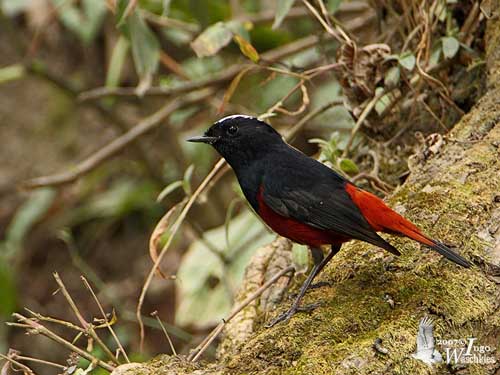
BEHAVIOUR:
The White-capped Water-redstart feeds primarily on numerous insects, and also takes spiders and molluscs, and occasionally berries and seeds of grass.
The food is taken from the water surface, but this bird also performs flycatching sallies, or makes dashes among rocks, or wades in shallow water to catch its preys.
It occasionally forages away from water on boulders and cliffs.
The White-capped Water-redstart is usually seen on stony areas, repeatedly pumping, fanning and cocking the tail. During the displays, the white head patch and the tail pattern are probably enhanced by several postures accompanied by calls. The tail is fanned while the wings are dropped.
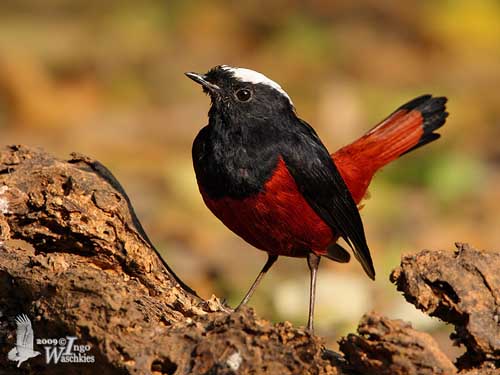
FLIGHT:
The White-capped Water-redstart is able to perform flycatching to catch insects. After landing, the bird often flickers the tail as numerous Muscicapidae species do.
REPRODUCTION:
The breeding season occurs between May and July-August.
The White-capped Water-redstart which breeds in high areas may nest in rocky meadows relatively far for running water. But usually, this species breeds along the largest rapid mountain streams, at about 100-200 metres of the water.
The nest is placed in hole, in rock, tree, bank or wall, under stone or tree roots. The bulky cup is fairly deep, and made with grass, rootlets and moss, bound with mud. The thick lining includes rootlets, ferns and animal hair.
The female lays 3-5 pale blue or blue-green eggs with darker markings.
Information about incubation and fledging period is lacking, but the young are fed by adults for 5-6 days after fledging.
This species usually produces two broods per season.
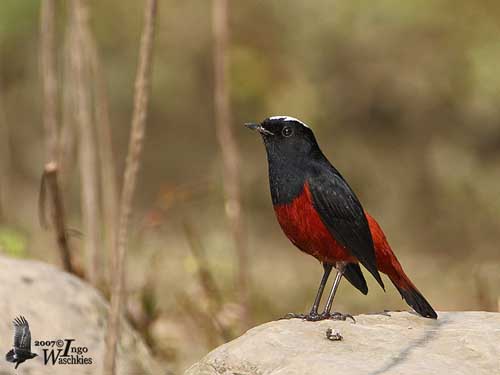
DIET:
The White-capped Water-redstart feeds primarily on various insect species such as ephemeropterans, dipteran flies, craneflies, beetles and ants. It also takes spiders and molluscs.
According to the season, it may consume occasionally berries and grass seeds.
PROTECTION / THREATS / STATUS:
The White-capped Water-redstart is uncommon or locally common throughout the range. It may be common to very common in China and India.
This species is not currently threatened.
